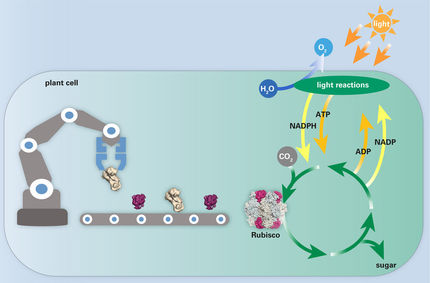Research team discovers previously unknown function of chloroplast chaperone
Better Understanding of Chlorophyll Synthesis
photosynthesis is an essential process for the existence of all organisms on our planet, in which sunlight is converted into biochemical energy. The pigment chlorophyll plays a key role in this process. A team of researchers at the Humboldt University of Berlin (HU) has now come up with new findings on how the synthesis of chlorophyll is regulated.
Sunlight is absorbed by the pigment chlorophyll and converted into biochemical energy through photosynthesis. The chlorophyll is integrated into light-harvesting chlorophyll-binding proteins (LHCPs) in the plant organelle chloroplast. Once these LHCPs have been synthesised in the zytoplasma and imported into the chloroplasts, they are transported onwards to their destination by the chloroplast signal recognition particles cpSRP43 and cpSRP54, where they are incorporated into the thylakoid membranes in which the photosynthetic processes occur. The chlorophylls are inserted while the LHCPs are being integrated into the membranes.
In order to ensure that sufficient amounts of chlorophyll are always available for the photosynthesis, the chlorophyll synthesis must be effectively coordinated with the provision of the LHCPs. The rate-limiting step of the chlorophyll synthesis is carried out with glutamyl-tRNA reductase (GluTR) — the first enzyme of the metabolic pathway. GluTR then ensures the required quantity of 5-aminolevulinic acid, the building block of all chlorophylls. The activity and stability of GluTR is regulated in a very diverse way. A research team at HU recently investigated exactly how this process is regulated.
Dr Peng Wang, a member of Prof Bernhard Grimm’s plant physiology work group, discovered that cpSRP43 exerts chaperone properties on the enzyme GluTR. More specifically, it supports the enzyme in the correct convolution and in the assembly in complexes. The cpSRP43 interacts with GluTR on “aggregation-prone motifs” (i.e. protein areas which are particularly prone to aggregate formation) and prevents the aggregation of the GluTR. This promotes the stability of the GluTR and helps avoid its inactivation.
Thus, in their recently published study, the researchers describe an additional function of the chaperone cpSRP43 in a new type of posttranslational control mechanism of the GluTR. Besides the transportation of the LHCPs within the chloroplasts, by stabilising GluTR, cpSRP43 also ensures the appropriate synthesis of the 5-aminolevulinic acid and thus the suitable amount of chlorophylls throughout continuously changing environmental conditions. The work group assumes that, thanks to the chaperone function, cpSRP43 now enables a linking of the tailor-made rates of the LHCP transportation as well as of the chlorophyll synthesis.
Original publication
Most read news
Original publication
Peng Wang, Fu-Cheng Liang, Daniel Wittmann, Alex Siegel, Shu-ou Shan and Bernhard Grimm; "Chloroplast SRP43 acts as a chaperone for glutamyl-tRNA reductase, the rate-limiting enzyme in tetrapyrrole biosynthesis"; PNAS; March 26, 2018. 201719645; published ahead of print March 26, 2018.
Organizations
Other news from the department science

Get the life science industry in your inbox
By submitting this form you agree that LUMITOS AG will send you the newsletter(s) selected above by email. Your data will not be passed on to third parties. Your data will be stored and processed in accordance with our data protection regulations. LUMITOS may contact you by email for the purpose of advertising or market and opinion surveys. You can revoke your consent at any time without giving reasons to LUMITOS AG, Ernst-Augustin-Str. 2, 12489 Berlin, Germany or by e-mail at revoke@lumitos.com with effect for the future. In addition, each email contains a link to unsubscribe from the corresponding newsletter.





















































